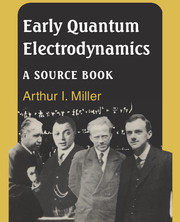Book contents
- Frontmatter
- Contents
- Preface
- Notes to the Preface
- Acknowledgements
- Notes to the Reader
- I Frame-setting essay
- Epilogue
- Notes
- References to the Frame-setting essay
- II Selected papers
- 1 The self-energy of the electron
- 2 Remarks on radiation theory
- 3 Theory of the positron
- 4 Discussion of the infinite distribution of electrons in the theory of the positron
- 5 The self-energy of the electron
- 6 Remarks on the Dirac theory of the positron
- 7 The quantization of the scalar relativistic wave equation
- 8 The electrodynamics of the vacuum based on the quantum theory of the electron
- 9 Theory of the emission of long-wave light quanta
- 10 The universal length appearing in the theory of elementary particles
- 11 The interaction between charged particles and the radiation field
- Index to Frame-setting essay
6 - Remarks on the Dirac theory of the positron
Published online by Cambridge University Press: 05 August 2012
- Frontmatter
- Contents
- Preface
- Notes to the Preface
- Acknowledgements
- Notes to the Reader
- I Frame-setting essay
- Epilogue
- Notes
- References to the Frame-setting essay
- II Selected papers
- 1 The self-energy of the electron
- 2 Remarks on radiation theory
- 3 Theory of the positron
- 4 Discussion of the infinite distribution of electrons in the theory of the positron
- 5 The self-energy of the electron
- 6 Remarks on the Dirac theory of the positron
- 7 The quantization of the scalar relativistic wave equation
- 8 The electrodynamics of the vacuum based on the quantum theory of the electron
- 9 Theory of the emission of long-wave light quanta
- 10 The universal length appearing in the theory of elementary particles
- 11 The interaction between charged particles and the radiation field
- Index to Frame-setting essay
Summary
Zeitschrift für Physik, 90: 209–31 (1934). Received 21 June 1934.
I. Intuitive theory of matter waves: 1. The inhomogeneous differential equation of the density matrix, 2. The conservation laws, 3. Applications (polarization of the vacuum). II. Quantum theory of wave fields: 1. Setting up the basic equations, 2. Applications (the self-energy of light quanta).
The intention of the present paper is to build the Dirac theory of the positron into the formalism of quantum electrodynamics. A requirement here is that the symmetry of nature in the positive and negative charges should from the very beginning be expressed in the basic equations of theory, and further that, except for the divergences which are caused by the well-known difficulties of quantum electrodynamics, no new infinities appear in the formalism, i.e. that the theory provides an approximation method for treating the group of problems which could also be treated according to the previous quantum electrodynamics. The latter postulate distinguishes the present attempt from the investigations of Fock, Oppenheimer and Furry, and Peierls, which it otherwise resembles; it is here rather closely connected with a paper by Dirac. Compared to Dirac's treatment, this paper emphasizes the significance of the conservation laws for the total system of radiation and matter, and the necessity of formulating the basic equations of the theory in a manner extending beyond the Hartree approximation.
- Type
- Chapter
- Information
- Early Quantum ElectrodynamicsA Sourcebook, pp. 169 - 187Publisher: Cambridge University PressPrint publication year: 1994
- 1
- Cited by



